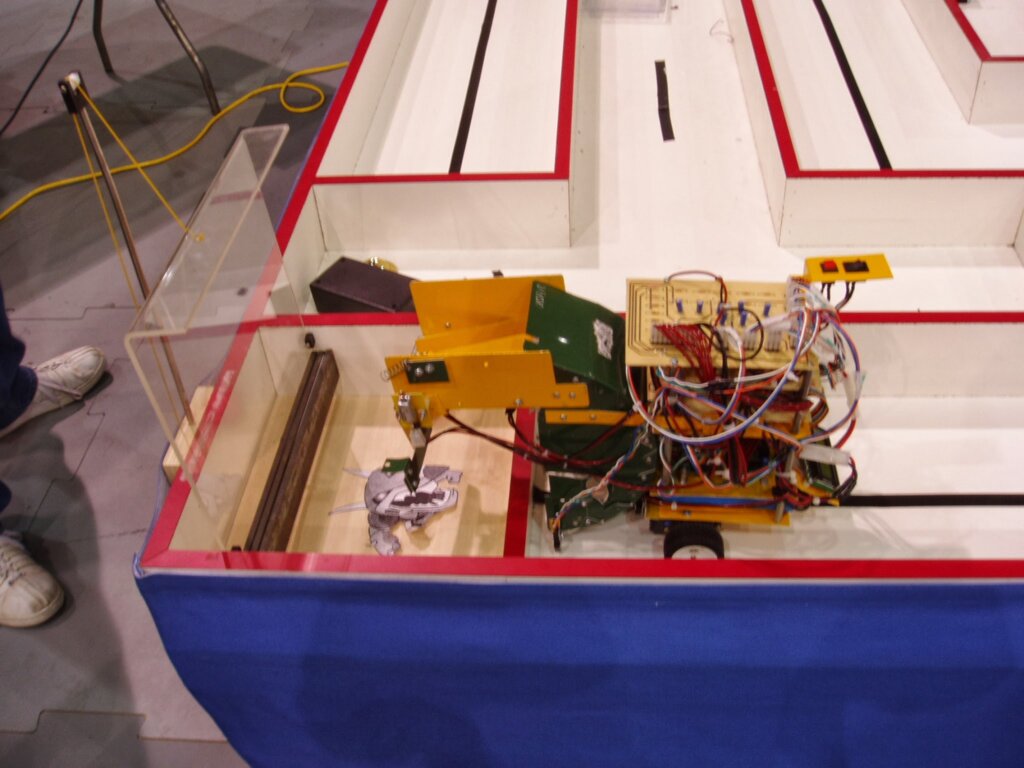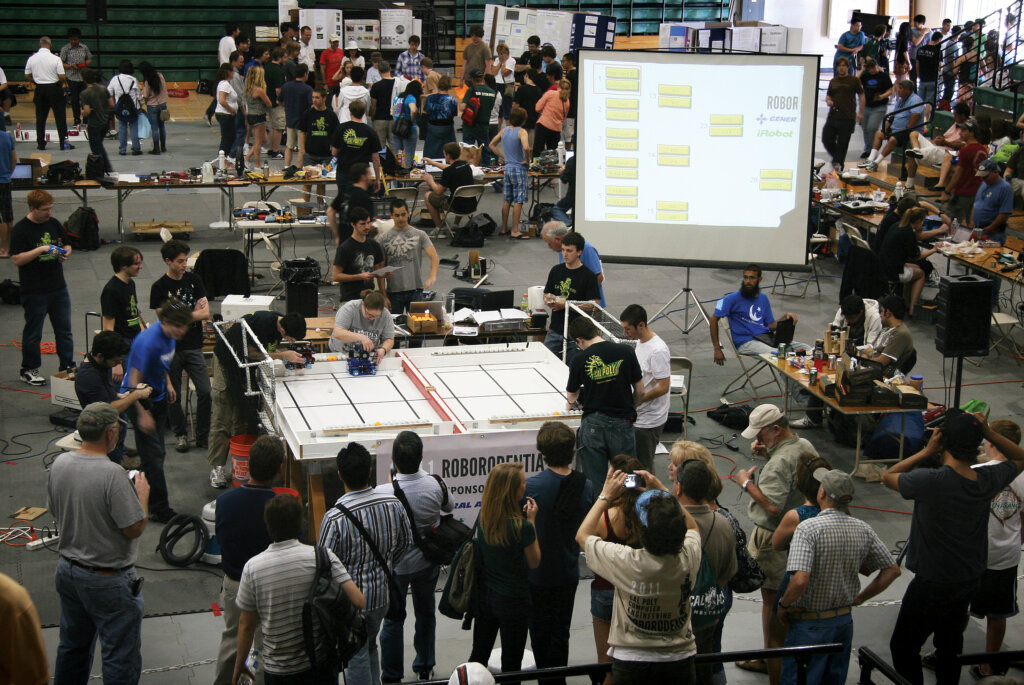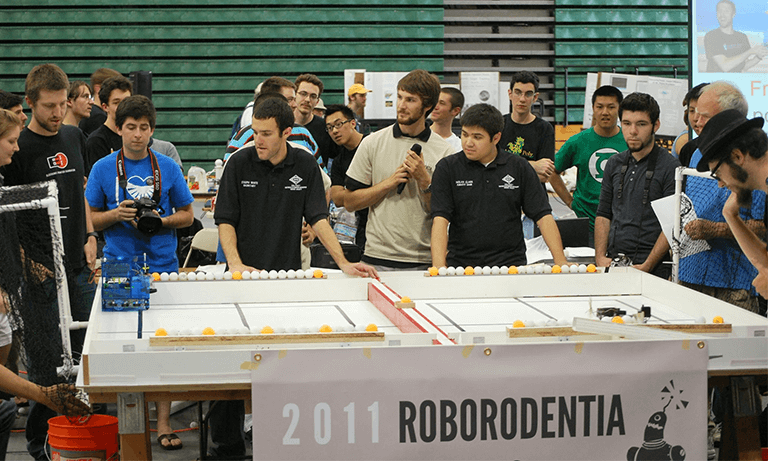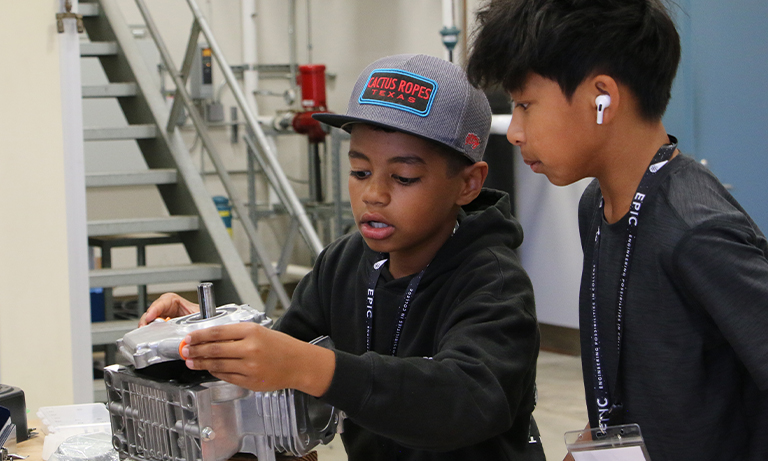Students, careers shaped by annual robotics competition
Cal Poly engineering alumnus Brian Starnes credits a robot with changing the course of his life.
In his final year studying computer engineering, Starnes registered for robotics classes after witnessing the fervor of Roborodentia – an annual robotics competition that pits autonomous machines against each other as they race to complete unique challenges.
“Something really clicked with me,” said Starnes who was inspired by the creativity, skill and passion he observed.
Starnes decided to construct his own robot for the 2005 contest which proved so rewarding that he shifted his focus from the field of web design to one that would involve both hardware and software.
“Making something tangible that I could automate was not only fun but eye-opening when I realized it was something I could do as a job,” he said.
The problem was Starnes didn’t know how he’d find employment after early academic challenges led to a 2.8 GPA.
“Most recruiters would have thrown out my resume,” he said.
With graduation looming, however, Starnes took a chance and visited a career fair at Chumash Auditorium with his Roborodentia robot in hand, having just left Professor John Seng’s robotics class.
A recruiter with General Atomics – a leading manufacturer of unmanned aircraft based in San Diego – spotted Starnes and beckoned him to his table.
“’You have a robot. You could probably code,’” said Starnes, recounting the recruiter’s words to him.
Starnes explained that his robot was programmed to follow a line, so the recruiter grabbed a piece of butcher paper, covered his table and drew a long, crooked line with a black Sharpie pen.
“He said, ‘If your robot can follow this line, I will get you an interview,’” Starnes said.
The recruiter made good on his promise, and the next day Starnes landed an interview to become one of the company’s software engineers.

‘A REAL HIGHLIGHT’
The roots of Roborodentia were planted in the late 1980s, when students organized robot demonstrations during Poly Royal, the precursor to Open House.
Those exhibitions evolved into competitions, with the inaugural Roborodentia held in 1996.
In the early days, autonomous robots would have to navigate a maze while searching for three randomly placed balls, collect them and then deposit them into a “nest” at the end of the maze. The robot with the most points would win a cash prize, according to Professor Joe Grimes, who served as the contest’s adviser for 10 years.
Initially, the event drew around seven students, then 20, then upwards of 15 to 20 teams, according to Grimes. Participants included Cal Poly students, industry members, alumni and teams from other universities, including one in South America.
“The contest became more and more popular,” Grimes said. “And it created tremendous excitement.”
Spectators began overflowing out of the competition’s view area in the lobby of Building 20A, so Roborodentia moved to a side room off Chumash Auditorium.
But that room also filled beyond capacity, flagging fire marshals to clear out the crowd, so the event alternated between Crandall Gym and the Recreation Center, where it has drawn upwards of 1,000 spectators.
“A lot of people have participated over the years and it’s a real highlight for them,” said Computer Engineering Department Chair Lynne Slivovsky.
Grimes believes Roborodentia was a capstone project for so many students because their investment went well beyond time spent.
“They put so much of their life into their robots,” said Grimes, who each year was wowed by the ingenuity and problem-solving skills he witnessed.
After graduating, many Roborodentia participants said competing or managing logistics of the student-run contest shaped their careers.
Including Starnes.
The Roborodentia robot he once took to the fortuitous career fair now sits in his office at General Atomics Aeronautical Systems in San Diego, where he designs “robots on a larger scale that fly around the sky.”
Starnes works a few doors down from fellow Cal Poly grad Adam Grenier, who incidentally partnered with Starnes in 2005 to build the robot.
Starnes recalled how the pair printed circuit boards and reused a piece of sheet metal stamped with “D. Fassio” – likely the name of the student who had tossed the metal into the trash after a project blunder – to construct the robot who became known as D. Fassio.
D. Fassio took third after navigating the maze and collecting golf balls, losing to a team from the University of Colombia whose South American students had spent three years perfecting the machine.
Seng, who succeeded Grimes as the faculty adviser for Roborodentia in 2004, remembers D. Fassio well.
So well that fourteen years after watching D. Fassio navigate the maze, Seng spied him while on a visit to General Atomics, a company that has hired countless Cal Poly graduates.
Seng chuckled about recognizing the robot in Starnes’ office as he recalled other robots from the past, programmed to collect balls, or in later years, stack rings and colored cat food cans.
A student committee with Seng’s guidance have designed various tasks over the years, ensuring teams don’t repeat with the same robot.
While the committee planned the 2011 challenge – shooting Ping-Pong balls into a small, soccer-style goal – Starnes and three of his General Atomics co-workers in San Diego joked about returning to compete.
But joking soon turned to planning as Starnes, Nick Hebner, Patrick McCarty and Antonio Hernandez found themselves brainstorming battle-ready robots.
This time instead of scrap metal, Starnes used high-tech materials and tools to help his team construct a robot that would separate into three machines on the competition floor to score maximum points.
“We made it way cooler,” Starnes said.
They named their robot Ball Reaper after their company’s MQ-9 Reaper – the primary offensive strike unmanned aerial vehicle for the U.S. Air Force – and just like its namesake, Ball Reaper carried out a successful strike at Roborodentia, earning the grads a first-place win.

‘DON’T GIVE UP’
Coming full circle, Starnes now recruits for General Atomics, reaching out to students with an interest in robotics just like him.
“I have hired a bunch of kids who have competed at Roborodentia,” Starnes said. “They are some of our top engineers.”
Cal Poly ranks in the top two or three schools from which the company recruits because of its Learn by Doing education, he added.
“The Cal Poly grads hit the ground running; they have not only learned theory but have applied it,” Starnes said. “There is so much to be learned while trying and you don’t get that unless you do projects and apply the theory.”
As a recruiter, Starnes has attended many career fairs at Cal Poly, where he shares his story of perseverance to inspire the future engineers.
“I tell them not to give up,” he said. “I didn’t have the greatest GPA but sometimes it’s more about showing what you can do.”

By Emily Slater


